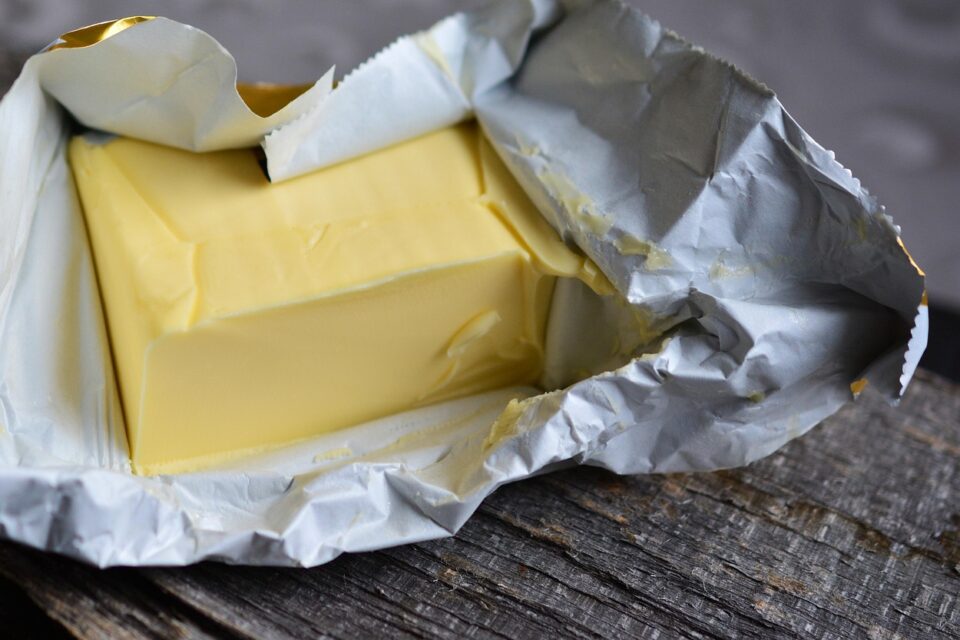An indispensable ingredient in chocolate-making, since butter is one of the main components of ganache: an emulsion of chocolate, butter and cream with added flavours.
The milk fat in butter has a lower melting point than cocoa butter, which contributes to a ganache that is smooth and melts on the tongue. This lower melting point allows the complex flavors of the chocolate to be released more readily, resulting in a more intense and immediate taste sensation.
Butter is the secret behind the silken center of a perfectly crafted chocolate truffle that yields to the slightest pressure, and the glossy, seductive sheen on a meticulously glazed bonbon.
The science of butter
Butter, being a water-in-fat emulsion itself, aids in stabilizing the ganache’s fat-in-water emulsion. It helps to prevent the ganache from splitting or becoming grainy, resulting in a consistently smooth and workable product. This is particularly crucial for pastry chefs who rely on the stability of their ganaches for piping, filling, and glazing.
A ganache enriched with a touch of butter provides the perfect consistency – firm enough to hold its shape, yet soft enough to provide a delightful contrast to the crisp shell.
However, not all butter is created equal, and this is where the emphasis on quality is important: the flavor of the butter will directly impact the final taste of the ganache. Using a generic, lower-quality butter can introduce unwanted flavors or a greasy aftertaste that can mar the delicate notes of a fine chocolate.
For this reason, professional chocolatiers and pastry chefs almost exclusively opt for high-quality, unsalted, cultured butter.
Cultured butter, with its slightly tangy and more complex flavor profile, can add a subtle depth to the ganache that complements the chocolate beautifully. The absence of salt is also critical. While a pinch of salt can enhance flavor, pre-salted butter offers no control over the final seasoning of the ganache. By using unsalted butter, the creator can add a precise amount of salt to perfectly balance the sweetness and bitterness of the chocolate.
European-style butters, known for their higher fat content (typically 82% or more, compared to the 80% in standard American butter), are often favored for their richer flavor and superior texture. This higher fat content translates to a creamier, more luxurious ganache.
Good butter rules
A chocolate using a high-fat, cultured butter will result in a confection with a pronounced dairy richness that harmonizes with the bitter notes of dark chocolate, creating a truly sophisticated dessert. In contrast, a filling made with a lower-quality, salted butter (or heaven forbid, margarine!) may result in flat, greasy, or even slightly artificial flavours, completely altering the intended profile and decreasing the quality of the product.
It’s important to also mention that a ganache made with high-quality butter will not only taste better but will also have a more desirable consistency. It will be smoother to work with, will set with a beautiful sheen, and will have a longer shelf life. This is because the higher fat content and lower water content of premium butters contribute to a more stable emulsion.
While butter is a key ingredient in the world of chocolate-making, it’s important to understand its limitations:
Butter cannot be used to temper chocolate.
Use the best unsalted butter you can find.
Do not boil or burn butter.
Never user butter spreads or margarine.
The crystalline structure of cocoa butter is what allows chocolate to be tempered, giving a finished chocolate bar its characteristic snap, gloss, and stability at room temperature.
Dairy butter, with its different fat composition and water content, will not crystallize in the same way. Attempting to make a chocolate with dairy butter instead of cocoa butter will result in a soft, fudge-like confection that will not hold its shape and will have a greasy texture and poor mouthfeel.
In conclusion
The partnership between butter and chocolate is a nuanced and rewarding one, a testament to the power of quality ingredients. While cocoa butter remains the unyielding backbone of solid chocolate, butter steps in as the creamy confidante, transforming ganaches, fillings, and glazes into creations of unparalleled richness and flavor.
From the silken heart of a hand-rolled truffle to the glossy crown of a perfect opera cake, the thoughtful inclusion of a high-quality, high-fat butter is a hallmark of a true artisan. It is a simple yet reminder that in the delicate world of chocolate making, every ingredient matters, and the pursuit of excellence begins with the very best that nature and craftsmanship have to offer.
